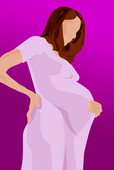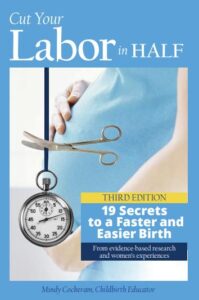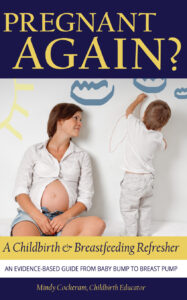.
Private Childbirth & Breastfeeding Education
Providing private in-person and virtual Childbirth & Breastfeeding Classes for a positive birth experience. Click Private Class Enquiry for more information.
 Recently a popular British TV drama series about six pregnant couples in an antenatal group called ‘In The Club’ mistakenly mentioned that the reduction of fetal movement, referred to as RFM, in the third trimester was ‘normal’ because babies ‘run out of space’. Seventeen charities, including The Royal College of Midwives and my old employer The National Childbirth Trust complained to the BBC about the inaccuracy of the comment. The obvious concern was that a reduction in a baby’s kicks or movement would not be taken seriously by mothers viewing the show and perhaps stop them from asking questions or seeking immediate care in the case of a slowdown. According to the Royal College of Ob/Gyns (RCOG’s) Green Top Guideline 57 (2011), ‘Clinicians should be aware (and should advise women) that although fetal movements tend to plateau at 32 weeks of gestation, there is no reduction in the frequency of fetal movements in the late third trimester.’
Recently a popular British TV drama series about six pregnant couples in an antenatal group called ‘In The Club’ mistakenly mentioned that the reduction of fetal movement, referred to as RFM, in the third trimester was ‘normal’ because babies ‘run out of space’. Seventeen charities, including The Royal College of Midwives and my old employer The National Childbirth Trust complained to the BBC about the inaccuracy of the comment. The obvious concern was that a reduction in a baby’s kicks or movement would not be taken seriously by mothers viewing the show and perhaps stop them from asking questions or seeking immediate care in the case of a slowdown. According to the Royal College of Ob/Gyns (RCOG’s) Green Top Guideline 57 (2011), ‘Clinicians should be aware (and should advise women) that although fetal movements tend to plateau at 32 weeks of gestation, there is no reduction in the frequency of fetal movements in the late third trimester.’
This got me thinking about my own classes and the information (or lack thereof) I was providing on fetal movements – specifically kick counts. I canvassed a few of my colleagues to find out what they said in class and got a wide range of responses. What should I be teaching and what does the evidence say? Can the mother’s own fetal surveillance of kick counts decrease the chance of a stillborn baby or improve the possibility of early intervention to a compromised one? How many babies give ‘warning shots’ that could be detected early?
In the first few hours I spent researching reduced fetal movement and surveillance, I was reminded of several sad facts about stillborn births (defined as intrauterine fetal demise – IUFD – after 20+ weeks of gestation in the USA). According to the National Center for Health Statistics (2015), stillborn babies represented almost 1% of pregnancies in 2013 – that’s roughly 24,000 per year. Of that number, 5000 are ‘term’ (38+ weeks) pregnancies and roughly half of those 5000 term demises are ‘unexpected and unexplained’ (Darby-Stewart Al et al, 2009) and give no warning signs at all. What I found even more worrying in the Darby study was that ‘unexplained stillbirth’ (stillbirth from unknown causes) is more likely to occur the further along a woman is in her pregnancy.
That got me thinking about the other 2500 intrauterine fetal demises that had given warning signals and also those other lucky babies whose mothers picked up those signs and intervened – avoiding becoming part of that statistic. Can awareness of fetal movement by their mothers save babies? Looking for an evidence-based answer, I found that the Darby-Stewart study had posed the same question: Do abnormal fetal kick counts predict intrauterine death in average-risk pregnancies? The Journal of Family Practice had published an analysis (Warren, 2009) of the study and in the ‘Evidence-Based Answer’ section concluded:
“No. Structured daily monitoring of fetal movement doesn’t decrease the rate of all-cause antenatal death in average-risk pregnancies (strength of recommendation [SOR]: B, single good-quality, randomized controlled trial [RCT]). Although maternal perception of decreased fetal movement may herald fetal death, it isn’t specific for poor neonatal outcome (SOR: B, single good-quality, diagnostic cohort study). Monitoring fetal movement increases the frequency of non-stress-test monitoring (SOR: B, single good-quality RCT).”
While the conclusion wasn’t what I was expecting, the sentence ‘although maternal perception of decreased fetal movement may herald fetal death’ stuck in my head. Looking to blogs, internet search engines and group chat, I quickly found story after story of women who felt that counting kicks had saved her child. I’d even had a recent birth story from a class member who said she “had become obsessed with kick counts” and credited her recognition of reduced fetal movement (RFM) as the trigger that led her to seek help – ultimately leading to an emergency C-Section for placental abruption. Surely it would be useful to teach every mother about decreasing or ceasing of fetal movement even if it couldn’t save every compromised baby?
Now on a mission for more conclusive and wide-ranging information, I went to the almighty Cochrane Database and found a Systematic Review less than a year old (Oct, 2015) which looked at five studies representing over 71,000 women. Cochrane concluded:
“This review does not provide sufficient evidence to influence practice. In particular, no trials compared fetal movement counting with no fetal movement counting. Only two studies compared routine fetal movements with standard antenatal care, as defined by trial authors. Indirect evidence from a large cluster-RCT suggested that more babies at risk of death were identified in the routine fetal monitoring group, but this did not translate to reduced perinatal mortality. Robust research by means of studies comparing particularly routine fetal movement counting with selective fetal movement counting is needed urgently, as it is a common practice to introduce fetal movement counting only when there is already suspected fetal compromise.”
That last sentence gave me clarity. Just because the current evidence doesn’t wholly identify kick counts as a means to reducing stillbirth doesn’t mean that we shouldn’t educate women as to its possible importance – in fact quite the contrary. It seems the conclusive research just hasn’t been done yet. In a commentary on ACOG guidelines for fetal surveillance in Contemporary OB/GYN (2015), Dr Haywood L. Brown, MD states that “Fetal kick counting in current antenatal clinical care appears to be underutilized and clinicians should be reminded to educate women about this modality in antenatal care”.
So if we are to teach women about monitoring for fetal movement (kicks, flutters, swishes and rolls), what recommendations should we use? For many years ACOG had no specific guidelines on what to advise patients but in 2014, ACOG updated Practice Bulletin Number 145 and addressed kick counts with a few pointers. The bulletin stated that “10 distinct movements in a period of up to 2 continuous or interrupted hours is considered reassuring. A non-reassuring count should prompt notification for further fetal assessment.” UK care providers are given particularly clear guidance to impart to women for measuring fetal movement (Green Top Guideline 57, 2015):
“If women are unsure whether movements are reduced after 28+0 weeks of gestation, they should be advised to lie on their left side and focus on fetal movements for 2 hours. If they do not feel 10 or more discrete movements in 2 hours, they should contact their midwife or maternity unit immediately.”
Several charitable websites like www.countthekicks.org and www.kickscount.org.uk also use the ’10 in 2’ guideline for recording baseline fetal movement for comparison. CountTheKicks.org suggests women begin counting as the third trimester begins and get to know their baby’s movements. Although they use the ’10 in 2’ as a guide, they also point out that “There is no magic number of movements a mother should feel. The most important thing is to monitor YOUR baby’s movements every day so you will know what is normal for YOUR baby.” CounttheKicks.org also suggests counting the kicks at the same time every day when the baby is awake and active – possibly after a meal. Both offer a downloadable app for recording and tracking daily fetal movement. CountTheKicks.org also offers a downloadable, printable chart as an alternative to using a smart phone or device.
Are there any downsides to women monitoring for reduced fetal movement? The only risks of making women aware of fetal movement guidelines that I could pinpoint is the raising of women’s anxiety levels and the potential for additional non-stress testing. Furthermore, if women don’t have extra time to monitor kick counts due to work commitments, the demands of family life, etc., they may feel a degree of guilt. However, like so many aspects of maternity care, reassurance that one can only do their best can go a long way to quell negative emotion and instill confidence. Non-stress testing may indeed increase and may not improve outcomes. But if just one baby’s life can be saved by arming mothers with fetal surveillance knowledge, isn’t it worth doing?
So while the evidence based research is not definitive in its support of using kick counting as a means to reduce poor neonatal outcomes, it seems obvious that fetal surveillance and awareness of reduced fetal movement by the mother is important – as is the way in which she is educated to use her instinct and get to know her baby while still in the womb.
What guidelines do you impart to those you educate? Do the Health Care Providers you work with discuss fetal surveillance with their patients? Do you feel counting kicks has made a difference to your class members?
References:
American College of Obstetricians and Gynecologists. (2014, July). Practice Bulletin No. 145: Antepartum Fetal Surveillance, Obstet Gynecol. 2014; 124:182–92450-463. Retrieved from http://contemporaryobgyn.modernmedicine.com/contemporary-obgyn/news/acog-guidelines-glance-antepartum-fetal-surveillance
Brown, Haywood L (2015) ACOG Guidelines at a Glance: Antepartum fetal surveillance. Contemporary OB/GYN. Retrieved from
http://www.countthekicks.org/how-to-count-the-kicks/ accessed June 5, 2016.
Darby-Stewart AL, Strickland C, Jamieson B, Warren J. (2009) Clinical inquiries: do abnormal fetal kick counts predict intrauterine death in average-risk pregnancies? J Fam Pract. 2009 Apr;58(4):220a-220c. Retrieved from
http://www.ncbi.nlm.nih.gov/pubmed/19358793
Macdorman MF, Gregory ECW (2015). Fetal and perinatal mortality, United States, 2013. National vital statistics reports; vol 64 no 8. Hyattsville, MD: National Center for Health Statistics. Retrieved from http://www.cdc.gov/nchs/data/nvsr/nvsr64/nvsr64_01.pdf
Mangesi L, Hofmeyr G, Smith V, Smyth RMD (2015). Fetal movement counting for assessment of fetal wellbeing. Cochrane Database of Systematic Reviews 2015, Issue 10. Art. No.: CD004909. DOI: 10.1002/14651858.CD004909.pub3
Royal College of Obstetricians and Gynaecologists. (2011, February). Reduced Fetl Movements. Green Top Guideline no 57. Retreived from https://www.rcog.org.uk/globalassets/documents/guidelines/gtg_57.pdf
Click to explore


Study: Hysterectomies during postpartum hemorrhages avoided with early intervention
www.fox17online.com
According to the World Health Organization (WHO), annually, 14 million women worldwide experience severe bleeding after childbirth, resulting in 70,000 deaths.
Sorry, comments are closed for this post.